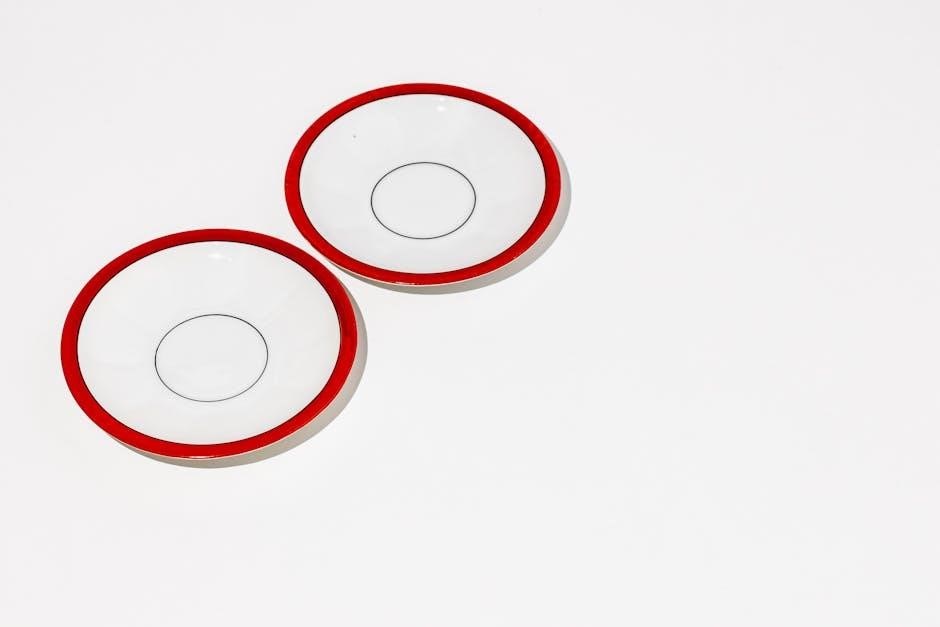Temperature conversion is essential for accurately measuring and comparing heat levels across different scales. Understanding Celsius, Fahrenheit, and Kelvin conversions is vital in science, engineering, and daily life. Worksheets with answers provide structured practice, ensuring mastery of these fundamental skills effectively.
Importance of Temperature Conversion Worksheets
Temperature conversion worksheets are vital for mastering heat measurement skills. They offer structured practice, enhancing understanding of Celsius, Fahrenheit, and Kelvin scales. With step-by-step exercises and answer keys, they build confidence, improve accuracy, and prepare students for real-world applications in science and engineering.
2.1 Benefits for Students
Temperature conversion worksheets offer numerous benefits for students, enhancing their understanding of heat measurement. They provide structured practice, helping students master formulas and apply them accurately. With step-by-step exercises, learners can grasp the relationships between Celsius, Fahrenheit, and Kelvin scales. Answer keys allow self-assessment, identifying areas for improvement and reinforcing problem-solving skills. These worksheets cater to different learning levels, from basic to advanced, ensuring comprehensive skill development. Regular practice builds confidence and fluency in temperature conversions, essential for science, engineering, and real-world applications. By using these resources, students develop a strong foundation in temperature measurement, preparing them for advanced studies and practical scenarios. The availability of free PDF downloads makes these tools accessible and convenient for homework or classroom use. Overall, temperature conversion worksheets are invaluable for students, fostering accuracy, mathematical precision, and a deeper understanding of temperature relationships.
2.2 Benefits for Educators
Temperature conversion worksheets with answers provide significant benefits for educators, streamlining lesson planning and instruction. These resources save time by offering pre-designed exercises, formulas, and step-by-step solutions, allowing teachers to focus on teaching rather than material preparation. The structured format ensures consistency in delivering content, aligning with curriculum goals. Educators can cater to diverse learning needs by selecting worksheets that match different skill levels, from basic to advanced conversions. Answer keys enable quick and accurate grading, while detailed solutions help address common student misconceptions. These worksheets also facilitate differentiated instruction, supporting visual and kinesthetic learners through clear layouts and practical examples. Additionally, they promote active learning, encouraging students to engage with real-world applications of temperature conversion. By integrating these worksheets into their teaching, educators can enhance student understanding, improve retention, and foster a deeper appreciation for scientific principles. Overall, temperature conversion worksheets are a valuable tool for educators, simplifying instruction and elevating student outcomes.
Key Formulas for Temperature Conversion
The primary formulas for temperature conversion are essential for accuracy. To convert Celsius to Fahrenheit, use F = (C × 9/5) + 32. For Fahrenheit to Celsius, use C = (F ౼ 32) × 5/9. To convert Celsius to Kelvin, use K = C + 273.15.
3.1 Celsius to Fahrenheit
Converting temperatures from Celsius to Fahrenheit is a fundamental skill in temperature conversion. The formula to convert Celsius to Fahrenheit is:
F = (C × 9/5) + 32. This formula ensures accurate conversion by first multiplying the Celsius temperature by 9/5 and then adding 32. For example, to convert 10°C to Fahrenheit:
10 × 9/5 = 18, then 18 + 32 = 50°F. Similarly, 30°C becomes 86°F using the same method.
Practicing with worksheets helps reinforce this process and reduces errors. Regular practice ensures mastery of this essential skill, making temperature conversion straightforward and efficient.
Worksheets with answer keys provide step-by-step exercises, allowing students to verify their calculations and improve accuracy. By following these steps, anyone can confidently convert Celsius to Fahrenheit with precision.
3.2 Fahrenheit to Celsius
Converting temperatures from Fahrenheit to Celsius is a crucial skill for understanding temperature relationships. The formula to convert Fahrenheit to Celsius is:
C = (F ౼ 32) × 5/9. This process involves subtracting 32 from the Fahrenheit temperature before multiplying by 5/9. For example, to convert 50°F to Celsius:
50 ౼ 32 = 18, then 18 × 5/9 = 10°C. Similarly, 86°F becomes 30°C using the same method.
Worksheets with answer keys provide structured exercises to practice this conversion, helping students master the formula and improve accuracy. Regular practice ensures fluency in converting temperatures between scales, which is essential for science, cooking, and weather-related tasks.
By following these steps, anyone can confidently convert Fahrenheit to Celsius with precision. These exercises are particularly useful for reinforcing problem-solving skills and understanding temperature relationships. Mastering this conversion enhances accuracy and consistency in both academic and real-world scenarios.
3.3 Converting to Kelvin
Converting temperatures to Kelvin is essential for scientific applications, as it represents absolute temperature. The conversion from Celsius to Kelvin is straightforward:
K = C + 273.15. For example, 36°C becomes 309.15 K by adding 273.15. To convert Fahrenheit to Kelvin, first convert to Celsius using the formula C = (F ౼ 32) × 5/9, then add 273.15. For instance, 50°F converts to 10°C, then to 283.15 K.
Worksheets with answer keys provide step-by-step exercises to practice these conversions, ensuring accuracy and understanding. Regular practice helps students master Kelvin conversions, which are critical in fields like chemistry and physics. By following these formulas, learners can confidently convert temperatures to Kelvin with precision, enhancing their problem-solving skills and familiarity with scientific notation. These exercises are vital for advanced studies and real-world applications, where absolute temperature measurements are required.
How to Use Temperature Conversion Worksheets
Using temperature conversion worksheets is a straightforward process that helps students master the skills of converting between different temperature scales. Start by selecting a worksheet that matches your skill level, such as basic conversions between Celsius and Fahrenheit or more advanced tasks involving Kelvin. Review the formulas provided on the worksheet, such as C = (F ౼ 32) × 5/9 for Fahrenheit to Celsius and F = (C × 9/5) + 32 for Celsius to Fahrenheit. Understanding these formulas is key to accurate conversions.
Work through each problem step-by-step, ensuring you apply the correct formula. For example, subtract 32 before multiplying when converting Celsius to Fahrenheit. Pay attention to the order of operations to avoid errors. After completing the exercises, compare your answers with the provided answer key to assess your performance. Identify and correct any mistakes to improve your understanding.
Practice regularly to build confidence and speed. These worksheets are available in PDF format, making them easy to print and use for homework or classroom activities. By following this guide, learners can effectively use temperature conversion worksheets to enhance their math and science skills. Regular practice ensures mastery of temperature scale conversions.
Types of Temperature Conversion Worksheets
Temperature conversion worksheets come in various types to cater to different learning needs. Basic worksheets focus on straightforward conversions between Celsius and Fahrenheit. Mixed-unit worksheets combine multiple scales for comprehensive practice. Word problem worksheets apply conversions to real-world scenarios, enhancing practical understanding and problem-solving skills.
- Basic Conversion Worksheets: Focus on direct conversions between two scales.
- Mixed-Unit Conversion Worksheets: Include conversions between Celsius, Fahrenheit, and Kelvin.
- Word Problem Worksheets: Apply temperature conversions to real-life situations.
These variations ensure learners can practice according to their skill level and learning objectives, making temperature conversion engaging and effective.
5.1 Basic Conversion Worksheets
Basic conversion worksheets are designed for learners to practice straightforward temperature conversions between two scales, typically Celsius and Fahrenheit. These worksheets are ideal for beginners, as they focus on reinforcing the fundamental formulas and skills needed for accurate conversions. They usually include a series of numerical problems that require students to apply the conversion formulas step-by-step. For example, converting Celsius to Fahrenheit using the formula ( F = (C imes rac{9}{5}) + 32 ) or converting Fahrenheit to Celsius using ( C = (F ౼ 32) imes rac{5}{9} ).
These worksheets often come with detailed answer keys, allowing students to self-check their work and identify areas for improvement. They are structured to build confidence and fluency in temperature conversion, ensuring a strong foundation for more complex tasks. Basic conversion worksheets are widely available in PDF format, making them easy to print and use for classroom or homework activities. They are particularly useful for students just starting to learn temperature conversion, as they provide a clear and focused way to master the essential skills.
By practicing with basic conversion worksheets, learners can develop a solid understanding of how to switch between Celsius and Fahrenheit, preparing them for more advanced conversions involving Kelvin and real-world applications. These resources are simple, effective, and tailored to meet the needs of students at various educational levels.
5.2 Mixed-Unit Conversion Worksheets
Mixed-unit conversion worksheets are designed to challenge learners by combining conversions between multiple temperature scales, such as Celsius, Fahrenheit, and Kelvin. These worksheets are ideal for students who have mastered basic conversions and are ready to tackle more complex problems. They often include a variety of exercises that require converting temperatures from one scale to another in different contexts, ensuring a comprehensive understanding of temperature relationships.
These worksheets are particularly useful for developing problem-solving skills, as they require learners to apply multiple formulas and think critically about which conversion to use in each scenario. For example, a problem might ask to convert a temperature from Celsius to Fahrenheit and then to Kelvin, or vice versa. Mixed-unit worksheets also often include word problems that simulate real-world situations, such as scientific experiments or weather forecasting, where precise temperature conversions are essential.
Many mixed-unit conversion worksheets are available in PDF format, complete with step-by-step solutions and answer keys. They are structured to cater to different skill levels, from intermediate to advanced, and are widely used in classrooms and for independent study. By practicing with these resources, learners can enhance their ability to handle complex temperature conversions with accuracy and confidence.
5.3 Word Problem Worksheets
Word problem worksheets are an excellent way to apply temperature conversion skills to real-world scenarios. These worksheets present practical situations where learners must convert temperatures as part of solving a problem. For example, they might calculate the boiling point of water in different scales or determine the appropriate temperature for cooking a recipe. These exercises help students understand the relevance of temperature conversion in everyday life and scientific applications.
Word problems often involve multi-step conversions, requiring learners to think critically and apply their knowledge of formulas. For instance, a problem might ask to convert a freezer’s temperature from Fahrenheit to Celsius or determine the equivalent Kelvin temperature for a laboratory experiment. These exercises enhance problem-solving skills and reinforce the connection between temperature scales.
Many word problem worksheets include answer keys, allowing students to verify their solutions and identify areas for improvement. They are available in PDF format, making them easy to print and use for homework or classroom activities. By practicing with these resources, learners can develop a deeper understanding of temperature conversion and its practical applications, preparing them for real-world challenges in science, engineering, and beyond.
Common Mistakes and Error Avoidance
When working with temperature conversion, common mistakes often arise from formula confusion or calculation errors. A frequent error is reversing the conversion formulas for Celsius and Fahrenheit, such as using ( C = rac{5}{9}(F ⎼ 32) ) instead of ( F = rac{9}{5}C + 32 ). Another mistake is forgetting to subtract 32 when converting Fahrenheit to Celsius, leading to incorrect results; Additionally, misplacing decimal points or mishandling negative numbers can cause errors, especially in precise scientific applications.
To avoid these mistakes, it is essential to follow the conversion formulas step-by-step and double-check calculations. Using temperature conversion worksheets with answer keys can help identify and correct errors, ensuring a stronger understanding of the principles. Regular practice and attention to detail are key to mastering these conversions accurately. By addressing these common pitfalls, learners can improve their problem-solving skills and achieve consistent results in temperature conversion tasks.
Where to Find Temperature Conversion Worksheets
Temperature conversion worksheets with answers are widely available online in PDF format. Popular websites like mathworksheets4kids.com and edhelper.com offer free downloadable resources tailored for different skill levels.
These platforms provide step-by-step exercises, detailed formulas, and answer keys, making them ideal for students and educators seeking structured practice materials for mastering temperature conversion skills effectively.
7.1 Popular Websites for Download
Several popular websites offer free downloadable temperature conversion worksheets with answers in PDF format. MathWorksheets4Kids.com and EdHelper.com are top choices, providing a wide range of exercises for different skill levels.
Cuemath.com also offers structured worksheets designed for students to practice conversions between Celsius, Fahrenheit, and Kelvin. These resources often include step-by-step instructions, formulas, and answer keys for self-assessment.
Additionally, platforms like TeacherVision.com and SoftSchools.com cater to educators, offering customizable worksheets and interactive PDFs. Many of these websites provide specialized sheets for basic conversions, mixed-unit problems, and real-world applications.
These sites are popular due to their ease of use, free access, and variety of resources. They are ideal for students, teachers, and professionals seeking reliable materials to master temperature conversion skills effectively.
7.2 How to Download and Use
Downloading and using temperature conversion worksheets with answers in PDF format is a straightforward process. Start by visiting reputable websites like MathWorksheets4Kids.com or Cuemath.com, which offer free resources.
Browse through the available worksheets and select one that matches your needs, such as basic conversions or mixed-unit problems.
Click the download link to save the PDF file to your device. Most worksheets are free and require no registration.
Open the PDF using a viewer like Adobe Acrobat and print it for offline use.
Work through the exercises step-by-step, using the provided formulas as a guide.
Check your answers against the included answer key to identify mistakes and improve accuracy.
These worksheets are ideal for self-study or classroom use, offering a structured way to master temperature conversion skills. Regular practice ensures fluency in converting between Celsius, Fahrenheit, and Kelvin.
For added convenience, many worksheets are designed with interactive features, such as fillable fields, making them easy to use digitally or in print. Save the PDFs for future reference or share them with peers and students.
By following these steps, learners can effectively utilize temperature conversion worksheets to enhance their understanding and proficiency in handling temperature scales.
Temperature conversion worksheets with answers in PDF format are invaluable tools for mastering the essential skill of converting between Celsius, Fahrenheit, and Kelvin. These resources provide structured practice, step-by-step exercises, and detailed answer keys, ensuring learners can identify and correct mistakes effectively.
By using these worksheets, students and educators can enhance understanding and proficiency in temperature conversion, which is critical for science, engineering, and everyday applications. The availability of free, downloadable PDFs makes them accessible and convenient for use in classrooms or self-study.
Regular practice with these worksheets builds confidence, improves accuracy, and reinforces problem-solving skills. They cater to diverse learning needs, offering basic, mixed-unit, and word problem exercises. As a result, temperature conversion worksheets are indispensable for anyone seeking to master this fundamental skill.


